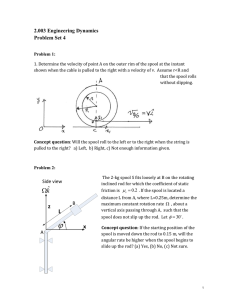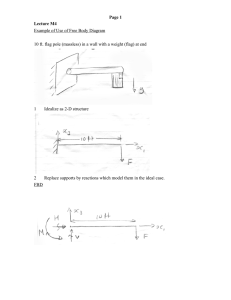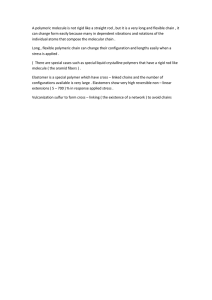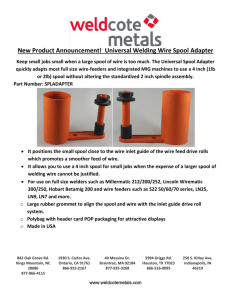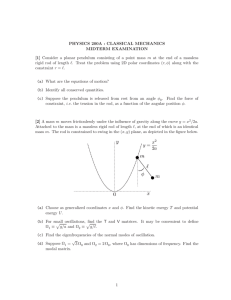Engineering Dynamics Problem Set 4 Solutions
advertisement
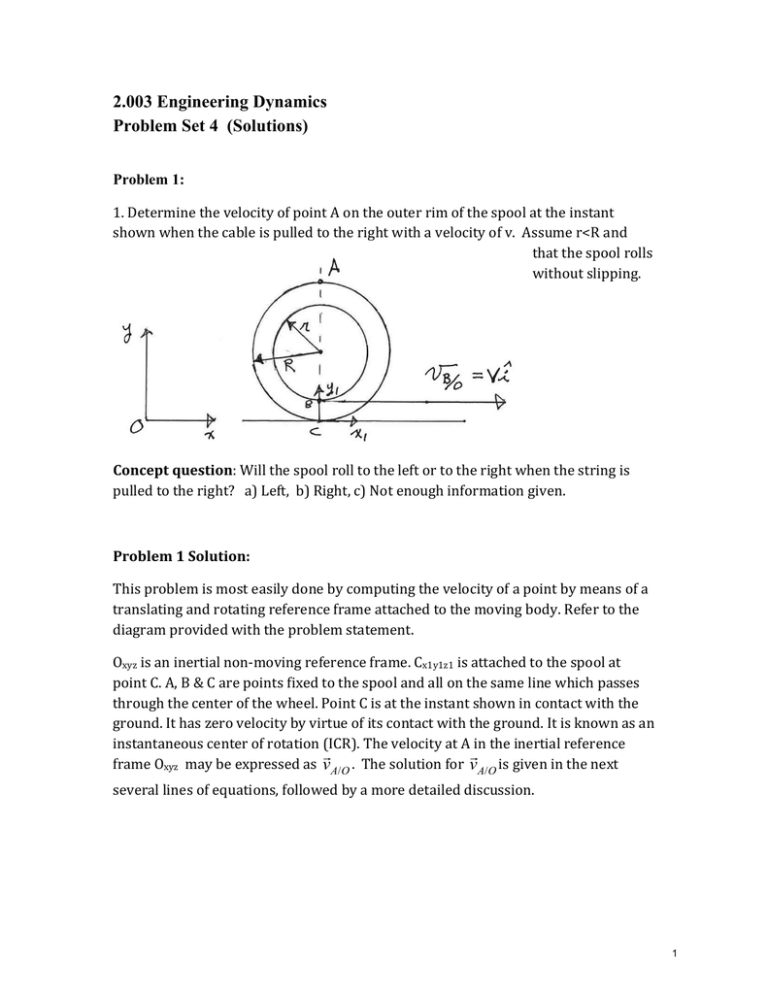
2.003 Engineering Dynamics Problem Set 4 (Solutions) Problem 1: 1. Determine the velocity of point A on the outer rim of the spool at the instant shown when the cable is pulled to the right with a velocity of v. Assume r<R and that the spool rolls without slipping. Concept question: Will the spool roll to the left or to the right when the string is pulled to the right? a) Left, b) Right, c) Not enough information given. Problem 1 Solution: This problem is most easily done by computing the velocity of a point by means of a translating and rotating reference frame attached to the moving body. Refer to the diagram provided with the problem statement. Oxyz is an inertial non-moving reference frame. Cx1y1z1 is attached to the spool at point C. A, B & C are points fixed to the spool and all on the same line which passes through the center of the wheel. Point C is at the instant shown in contact with the ground. It has zero velocity by virtue of its contact with the ground. It is known as an instantaneous center of rotation (ICR). The velocity at A in the inertial reference frame Oxyz may be expressed as vA/O . The solution for vA/O is given in the next several lines of equations, followed by a more detailed discussion. 1 vA/O vC /O vA/C vC /O 0, because C is an ICR. dr r vA/C ( A/C )/ Oxyz ( A/C ) / Cx y z / o rA/C 1 11 dt t (vA/C )rel / o rA/C (vA/C )rel 0 kˆ A B /O rA/C 2 Rjˆ1 vA/O vC /O (vA/C )rel kˆ 2 Rjˆ1 2 Riˆ1 vB /O vC /O vB /C 0 0 / o rB /C Viˆ Viˆ kˆ ( R r ) ˆj ( R r )iˆ V Rr Where vA/C is the velocity of A with respect to point C as seen from the inertial frame Oxyz. It has two terms. drA/C ∂rA/C vA/C = ( )/Oxyz = ( )/Cx1y1z1 + ω /o × rA/C dt ∂t B A = (vA/C )rel + ω /o × rA/C Term A is the ‘relative’ velocity between points A and C as seen from an observer attached to the spool, or fixed in the Cx1y1z1 frame. The Williams books calls this term (vA/C )rel (vA/C )rel = 0 . Now to the problem: ω /O = ω k̂ and is for the moment unknown. ˆ v = v A/O C/O + (vA/C )rel + ω k̂ × 2Rĵ1 = −2Rω i1 [1] ω is unknown but may be found because the vB/O is given. 2 vB/O = vC/O + vB/C = 0 + 0 + ω /o × rB/C = Viˆ Viˆ = ω k̂ × (R − r) ĵ = −ω (R − r)iˆ Therefore ω = −V which may be put into equation [1] R−r 2R ˆ )Vi . Note that at the instant shown the unit vectors of since vA/O = −2Rω iˆ = ( R−r frames O and C align and are interchangeable., i.e. iˆ = iˆ, ĵ = ĵ, k̂ = k̂ . 1 1 1 Problem 2: The 2-kg spool S fits loosely at B on the rotating inclined rod for which the coefficient of static friction is s 0.2 . If the spool is located a Side view k̂ z distance L from A, where L=0.25m, determine the maximum constant rotation rate , about a vertical axis passing through A, such that the B L A spool does not slip up the rod. Let 30 . x Concept question: If the starting position of the spool is moved down the rod to 0.15 m, will the angular rate be higher when the spool begins to slide up the rod? (a) Yes, (b) No, (c) Not sure. Problem 2 Solution: What is the maximum rotation rate such that the spool does not move along the rod? In other words, the rotation rate such that the spool will have no velocity component along the rod. The only velocity of the spool will be due to its constant rotation. 3 Describe the motion: Use two moving reference frames. The first Axyz is attached to the shaft and rotates with the shaft at ω /O = ω k̂ . The second is attached to the spool at B and rotates with the spool. Call it Bx1y1z1. It is needed so that the forces parallel to and perpendicular to the rod may be easily identified. In order for dynamic equilibrium to be satisfied on the spool so that it does not slip Newton’s 2nd law may be used. ∑F ext .spool d = maB/O = P/O dt The second expression, showing the time rate of change of the linear momentum provides a particularly direct solution. 4 P/ O mvB / O m(/ O rB / A ) kˆ /O rB / A Liˆ1 L(cos iˆ sin kˆ) v kˆ ( L cos iˆ L sin kˆ) B /O Lˆj Lˆj1 , because ˆj and ˆj1 are parallel dP/ O d djˆ (mLˆj ) mL dt dt dt djˆ kˆ ˆj iˆ dt dP Fext / O mL 2iˆ dt Fext mass times the centripetal acceleration This term can be broken into vector components in the iˆ1 and k̂1 directions. I particular iˆ may be expressed as: iˆ = cosφiˆ1 − sin φ k̂1 F ∑ ext = −mLΩ2iˆ = −mLΩ2 (cosφiˆ1 − sinφ k̂1 ) Next a free body diagram is needed to identify the external forces acting on the spool. 5 ∑F ∑F iˆ1 = − f − mgsin φ = −mLΩ2 cosφ k̂1 = N − mg cosφ = mLΩ2 sin φ (1) (2) The model of friction that is commonly used is that f = µ N (3). Solve (2) for N. Multiply the expression for N by µ and substitute into (1) for f. N = mg cosφ + mLΩ2 sin φ from (2). Then from (1) f = µ N = −mgsin φ + mLΩ2 cosφ = µ (mg cosφ + mLΩ2 sin φ ) (4) Solving equation (4) for Ω2 leads to: Ω2 = −mg( µ cosφ + sin φ ) mL( µ sin φ − cosφ ) 6 µ = 0.2 φ = 30 o for L = 0.25m g = 9.81 m s2 Ω = 5.87 radians sec Independent of the mass of the spool. Problem 3. This is a simple pendulum with a torsional spring at the pivot. Gravity acts. The torsional spring creates a restoring torque, which is proportional to the angle of rotation of the rod. The rod is of length 2L, rigid and without mass. Two masses are attached to the rod, one at the midpoint and one at the end. For the purpose of this problem the masses may be considered to be particles with mass M. (a) The masses and the rigid rod make up one rigid body, which has at most 6 degrees of freedom. However, in this problem the rigid body has 5 external constraints. Thus it has only one degree of freedom and will require only a single coordinate to completely describe its motion. Identify the 5 constraints. (b) Find the equation of motion of this pendulum by consideration of the time rate of change of the angular momentum computed with respect to the pivot. Be sure to include a free body diagram. Concept Question: The natural frequency of the pendulum without a torsional spring is independent of mass and equal to n 2g 3L How will the natural frequency change as a result of the addition 7 of the torsional spring. (a) Increase, (b) Decrease, (c) Stay the same. Problem 3 Solution: 3a) Given: N=1 rigid body This system has 1 Degree of Freedom and therefore must have 5 constraints. DOF = 6N-C = 1 ® C = 5 Constraints They are: No translation allowed at the pivot in x, y and z, which accounts for 3 of the 5 constraints. No rotation about x or y axes, which provides the two additional constraints. 3b) Obtain an EOM by consideration of angular momentum. This requires an application of Euler’s law about a fixed point. Because this rigid body is defined in terms of two simple particles it is easier to compute angular momentum from its basic definition than to bother with finding a mass moment of inertia. Euler’s law for rotation about a fixed point O. H /O dH / O dt r i Pi r i M 1v 1 r2 M 2v2 /O O O O O O O r1 Lrˆ, r2 2 Lr O O v 1 / O r1 kˆ Lrˆ Lˆ O O v2 / O r2 kˆ 2 Lrˆ 2 Lˆ O O H / O Lrˆ ( M 1 Lˆ) 2 Lrˆ ( M 2 Lˆ) 5ML2 kˆ where M 1 M 2 m A free body diagram is constructed as shown below and Euler’s law is applied. /O [kt ( M 1 2M 2 ) gL sin ]kˆ [kt 3mgL sin ]kˆ = dH / O 5mL2 kˆ dt Which may be rearranged to provide an EOM in standard form. 5mL2 kt 3mgL sin 0 8 For small angular motion about θ = 0 , θ ≈ sin θ which provides a linearized EOM. 5mL2 (kt 3mgL) 0 This is now in the standard form for any single DOF pendulum and is modeled as a linear 2nd order ODE. I eqθ + keqθ = 0 where the natural frequency ω n is given by: n keq I eq kt 3mgL 5mL2 Problem 4: This problem has multiple bodies. It consists of two masses, with springs and a dashpot, mounted on rollers on a horizontal surface. Unlike particles which are assumed to be points of mass, rigid bodies have finite dimensions and therefore rotational inertia. Each rigid body has six possible degrees of freedom: three in translation and three in rotation. The number of degrees of freedom is given by the expression DOF 6 N C , where N is the number of rigid bodies and C is the number of constraints. DOF is the number of independent degrees of freedom. For 9 each DOF you need to assign a coordinate to describe the motion. For most mechanical systems the number of DOFs equals the number independent coordinates needed to completely describe the motion of the system. When this is true the systems are called holonomic. More on that topic will be dealt with later in the course. This system is holonomic. You will use the equation above to establish the number of independent coordinates needed to solve this problem. (a) In this problem there are 2 rigid bodies and a possible 12 degrees of freedom. However, there are 10 constraints, which leads one to the conclusion that only two independent coordinates are needed to describe the motion. Describe the ten constraints that reduce the number of degrees of freedom to two. (b) Draw free body diagrams, assign two appropriate coordinates, and find the two equations of motion which characterize the system. Hint: To get the signs correct on the spring and dashpot forces, one at a time assume positive displacements and velocities of each coordinate and deduce the resulting directions of the spring and damper forces. Draw these forces on your free body diagrams. It is also strongly suggested that you assign coordinates so that they will be zero when the system is in its static equilibrium position. Concept question: If spring constant k1 were zero, the object is no longer constrained in the horizontal direction. The system still has two natural frequencies. Do you think it will be possible for the two masses to vibrate(oscillate) in such a way that the center of mass of the system does not move. (a) Yes (b) No (c) Not sure Problem 4 Solution: a) For holonomic system such as this one the number of independent coordinates required to completely describe the motion is equal to the number of degrees of freedom (DOF). There are two rigid bodies (N=2). DOF = 6N-C = 6*2-10 = 2 10 The number of constraints (C) is 10. They may be identified by considering each mass (rigid body) separately. M1: No rotation about x, y or z axes and no translation in the y or z directions. Thus C1 = 5. M2: Same constraints as M1, thus C2 = 5. C = C1+C2 =10 constraints on the system. DOF = 2 ® 2 Independent coordinates are required. For each mass the only allowable motion is translational in the x direction. Each rigid body is assigned its own coordinate, x1 and x2. In the absence of an initial disturbance or external force in the x direction these bodies will sit motionless in a “state equilibrium condition”. Let x1 = 0 and x2 = 0 in this state. This will generally lead to the simplest EOM. Two equations of motion may be obtained by a direct application of Newton’s 2nd law. Begin by drawing a free body diagram (fbd) for each mass. When multiple bodies are interconnected with springs and dashpots, it is easy to make errors in the sign on direction of the forces resulting from arbitrary displacements and velocities. A foolproof method is useful. One is recommended here. Method: Consider each rigid body separately so as to obtain on EOM for each rigid body. Then, one at a time, assume small positive deflections and velocities for all allowable DOFs in the system. In this case that will be x1, x1, x2 , and x2 . Begin with M1. M1 fbd construction: If M1 moves with positive x1 and x1, the spring and damper forces resist the motion. These forces are in the negative x1 direction and are drawn that way on the fbd. In other words the sign of the force is indicated by the direction of the arrow. Positive motions of body M2 require x2 , and x2 are positive. These result in negative, resisting forces on M2, but positive directed forces on M1. The final fbd for M1 is shown in the figure below. Next, one repeats the same sequence of assumed positive values of all displacements and velocities and then the resulting forces on M2 are deduced and drawn, and shown in the figure for the fbd of M2. 11 As the EOM is written, the direction of the force arrow on the fbd establishes the sign for each term. y = 0 → N1 = M 1g EOM for M1: ∑ Fy = N1 − M 1g = M 1 Since no minus sign appears in the final expression for N1 its direction is as drawn on the fbd. F x M 1 x k1 x1 k2 x1 k2 x2 b2 x1 b2 x2 Rearranging to standard form: M 1 x1 b2 x1 b2 x2 (k1 k2 ) x1 k2 x2 0 EOM for M 2 : F F y N2 M 2 g M 2 y 0 N2 M 2 g x M 2 x2 b2 x2 b2 x1 k2 x2 k2 x1 Rearranging to standard form: M 2 x2 b2 x2 b2 x1 k2 x2 k2 x1 0 Problem 5. A mass m1, attached to a string, is on top of a frictionless table. The mass is rotating 12 about a hole in the table through which the string passes. The initial rate of rotation is and the initial distance from mass m1 to the hole is lo . At the other end of the string, lying exactly on the axis of rotation, is another mass, m2. Note that gravity acts and that the contact of the string with the hole is without friction. a) Determine the number of degrees of freedom for this problem. b) Find the equation(s) of motion. c) Based on initial conditions given will the mass m1 begin moving inward or outward? Concept question: Is total system energy conserved in this problem after it is released? (a) Yes, (b) No, (c) Depends on initial conditions Problem 5 Solution: 5a) Find the number of degrees of freedom that this system has. DOF = 3M-C, where M = 2, the number of particles. ∴ DOF = 6 – C, where C is the number of constraints. Referring to the side view and top view figures below, M1 has 1 constraint—no motion in the z direction. M2 has 2 constraints—It is assumed to move only in the z direction and is constrained in x and z. A 4th constraint exists: the string connecting M1 and M2 is of fixed length. Therefore r = z and r = z. DOF = 6 – 4 = 2. Two 13 independent coordinates are needed to completely describe the motion. r and q will be used. 5b) Find the equations of motion: Begin by drawing free body diagrams for each mass. At the beginning there are three unknowns: the motions, r and q and the string tension T. There are three laws that can be applied: Newton’s 2nd applied to each mass and Euler’s torque-angular momentum relation applied to the mass circling the table top. M 1 : Fr M 1ar M 1 (r r 2 )rˆ Trˆ T M 1 ( r r 2 ) [1] T M 2r M 2 g [2] M 2 : Fz M 2 z M 2 r T M 2 g Substituting expression [1] into [2] for T and rearranging yields: ( M 1 M 2 )r M 1r 2 M 2 g 0 [3] Equation [3] is one of the two sought for EOMs. 14 Next apply Euler’s law for rotation about a fixed point O. H /O dH / O 0 There are no external torques with respect to point O. dt ri / O Pi / O rrˆ [ M 1 (/ O rrˆ)] /O H / O rrˆ M 1 ( kˆ rrˆ) M 1r 2 kˆ dH / O ( M 1r 2 2rM 1 r )kˆ 0 dt [4] H /O = constant ® angular momentum is conserved. [4] after dropping k̂ is the 2nd EOM. 5c) Upon release with initial conditions r = lo and θ = Ω does M1 start inward or outward. The answer is readily obtained from expression [3] after substitution of the initial conditions then solving for r . @ t = 0 z r M 2 g M1lo2 / M1 M 2 It will depend on which term in the numerator is largest. 15 MIT OpenCourseWare http://ocw.mit.edu 2.003SC / 1.053J Engineering Dynamics Fall 2011 For information about citing these materials or our Terms of Use, visit: http://ocw.mit.edu/terms.
